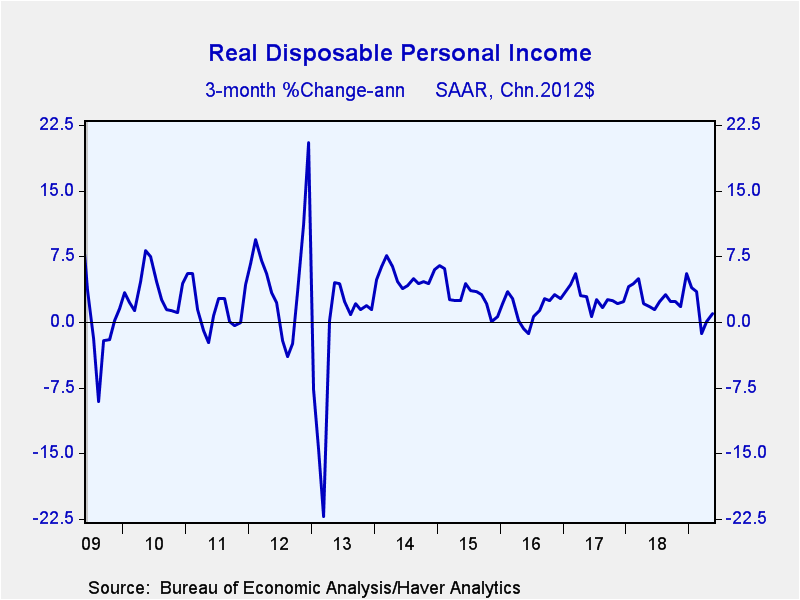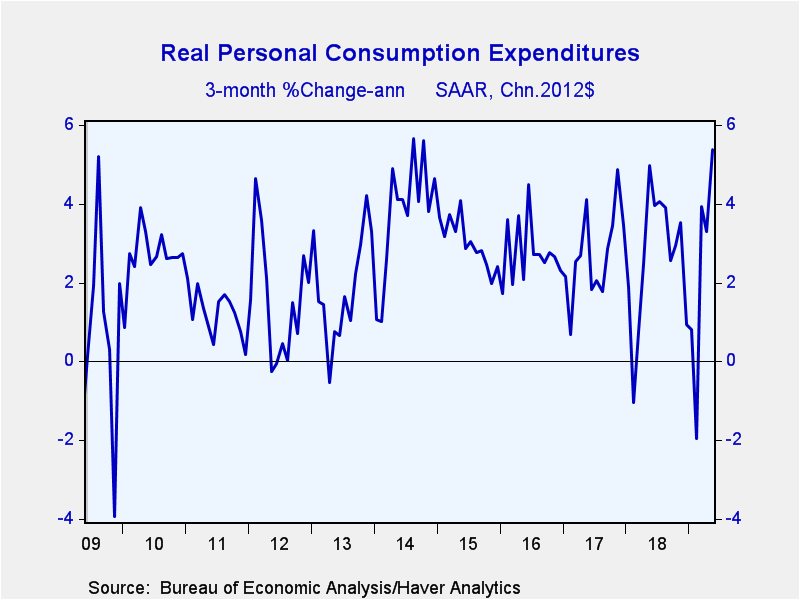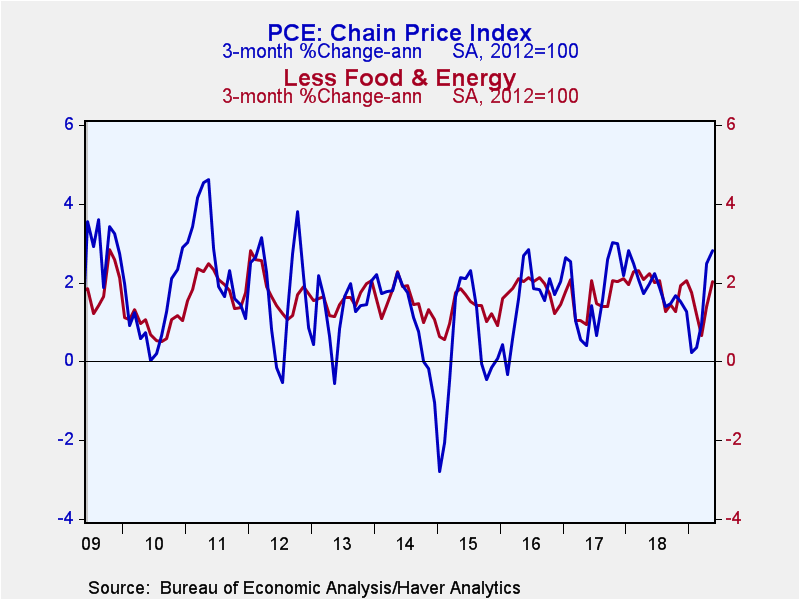 Global| Jun 28 2019
Global| Jun 28 2019U.S. Personal Income Growth Remains Firm, Encouraging Spending
by:Tom Moeller
|in:Economy in Brief
Summary
Personal income increased 0.5% (4.1% y/y) during May following an unrevised 0.5% April gain. A 0.3% rise had been expected in the Action Economics Forecast Survey. These monthly increases were the strongest since December. Wages & [...]
Personal income increased 0.5% (4.1% y/y) during May following an unrevised 0.5% April gain. A 0.3% rise had been expected in the Action Economics Forecast Survey. These monthly increases were the strongest since December. Wages & salaries increased 0.2% (3.6% y/y) after a 0.3% gain. Growth has been slowing since mid-2017. Proprietors income jumped 0.8% (2.8% y/y) after a 0.4% rise. Rental income improved 0.2% (4.8% y/y), the same as in April. Receipts on assets jumped 1.6% (3.7% y/y) for a second straight month. A 2.3% gain (3.8% y/y) in interest income was the second straight month of strong increase. A 0.5% rise (3.6% y/y) in dividend earnings was the third month of firm gain in the last four months. Personal transfer receipts increased 0.4% (7.4% y/y), the weakest increase in four months. Medicare receipts surged another 0.7% (10.8% y/y). Income from Social Security rose 0.2% (6.4% y/y), and Medicaid receipts firmed 0.8% (5.4% y/y) after four months of even stronger increase. Jobless insurance income recovered 1.2% (-3.2% y/y) after two months of meaningful decline.
Disposable income grew 0.5% (3.9% y/y), repeating the strongest rise in 2019. When adjusted for higher prices, take-home pay increased 0.3% (2.3% y/y), also the firmest monthly gain this year.
Personal consumption expenditures increased 0.4% during May (4.2% y/y) following a 0.6% April rise, revised from 0.3%. The 1.0% jump during March was little-revised. A 0.4% May increase had been expected. Durable goods spending strengthened 1.7% (3.8% y/y), reflecting a 3.3% surge (4.3% y/y) in car buying after a 0.6% dip. Spending on recreational goods & vehicles rebounded 1.0% (5.2% y/y) after easing 0.2%. A 0.5% (2.7% y/y) increase in furniture & home appliance sales followed a 0.6% rise. Spending on nondurable goods edged 0.1% lower (+3.1% y/y) after strength in three of the prior four months. Spending on gasoline & other energy products declined 3.2% (+0.2% y/y) with lower prices. Apparel purchases rose 0.3% (0.8% y/y), about as they did in April. Foods & beverage purchases held steady m/m with y/y growth falling to 1.6% from 4.8% at its peak in July of last year. Outlays on services rose a moderate 0.4% (4.7% y/y) for the second month in the last three. Recreation services spending eased 0.5% (+2.6% y/y) y/y) and reversed April's gain. Housing & utilities outlays improved 0.4% (4.8% y/y) following a 0.6% rise. Health care spending rose 0.5% (5.2% y/y) and outlays on transportation services gained 0.2% (4.0% y/y) following a 0.4% rise.
After adjustment for price inflation, personal consumption expenditures increased 0.2% (2.7% y/y) for the second consecutive month after a 0.8% jump during March.
The personal savings rate held steady at 6.1%, below December's 7.4% high. The level of personal savings fell 3.3% y/y.
The PCE chain price index rose 0.2% in May (1.5% y/y) after strengthening 0.3% during April. The price index excluding food & energy increased a steady 0.2% (1.6% y/y), the largest increases since December. Nondurable product prices ticked 0.1% higher both m/m and y/y, but fuel prices eased 0.4% (+1.1% y/y) after a 5.1% jump. The clothing & footwear price index eased 0.1% (-3.7% y/y) while food & beverage prices increased 0.3% (1.3% y/y) and reversed the prior month's rise. The services price index rose 0.2% (2.4% y/y) after a strong 0.4% April rise. Both transportation services and finance & insurance cost increases moderated significantly m/m, while rising 2.6% y/y and 3.1%, respectively. Recreation services prices declined 0.4% (0.0% y/y) and reversed the prior month's rise. Housing & utilities prices rose 0.2% (3.0% y/y) but the health care price index improved 0.3% (1.5% y/y). The durable goods price index rose 0.1% (-1.3% y/y), up for the first time in four months. The rise reflected a 0.4% (0.2% y/y) increase in household equipment costs, but price weakness elsewhere.
The personal income and consumption figures are available in Haver's USECON database with detail in the USNA database. The Action Economics figures are in the AS1REPNA database
Tom Moeller
AuthorMore in Author Profile »Prior to joining Haver Analytics in 2000, Mr. Moeller worked as the Economist at Chancellor Capital Management from 1985 to 1999. There, he developed comprehensive economic forecasts and interpreted economic data for equity and fixed income portfolio managers. Also at Chancellor, Mr. Moeller worked as an equity analyst and was responsible for researching and rating companies in the economically sensitive automobile and housing industries for investment in Chancellor’s equity portfolio. Prior to joining Chancellor, Mr. Moeller was an Economist at Citibank from 1979 to 1984. He also analyzed pricing behavior in the metals industry for the Council on Wage and Price Stability in Washington, D.C. In 1999, Mr. Moeller received the award for most accurate forecast from the Forecasters' Club of New York. From 1990 to 1992 he was President of the New York Association for Business Economists. Mr. Moeller earned an M.B.A. in Finance from Fordham University, where he graduated in 1987. He holds a Bachelor of Arts in Economics from George Washington University.










